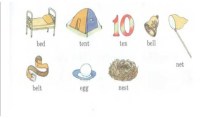- Главная
- Разное
- Бизнес и предпринимательство
- Образование
- Развлечения
- Государство
- Спорт
- Графика
- Культурология
- Еда и кулинария
- Лингвистика
- Религиоведение
- Черчение
- Физкультура
- ИЗО
- Психология
- Социология
- Английский язык
- Астрономия
- Алгебра
- Биология
- География
- Геометрия
- Детские презентации
- Информатика
- История
- Литература
- Маркетинг
- Математика
- Медицина
- Менеджмент
- Музыка
- МХК
- Немецкий язык
- ОБЖ
- Обществознание
- Окружающий мир
- Педагогика
- Русский язык
- Технология
- Физика
- Философия
- Химия
- Шаблоны, картинки для презентаций
- Экология
- Экономика
- Юриспруденция
Что такое findslide.org?
FindSlide.org - это сайт презентаций, докладов, шаблонов в формате PowerPoint.
Обратная связь
Email: Нажмите что бы посмотреть
Презентация на тему William I of England
Содержание
- 2. His reign, which brought Norman-French culture to
- 3. The Battle of Hastings lasted all day.
- 4. English coin of William the Conqueror (1066–1087)Battles
- 5. [The signatures of William I and Matilda
- 6. William also ordered many castlesWilliam also ordered
- 7. Скачать презентацию
- 8. Похожие презентации
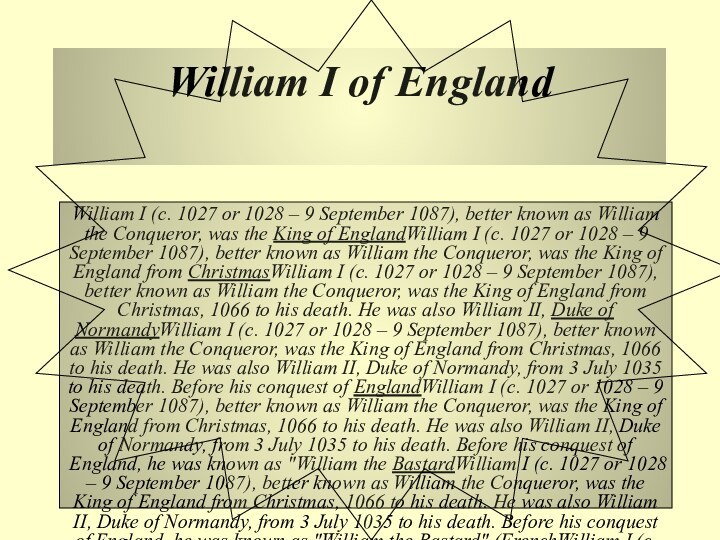
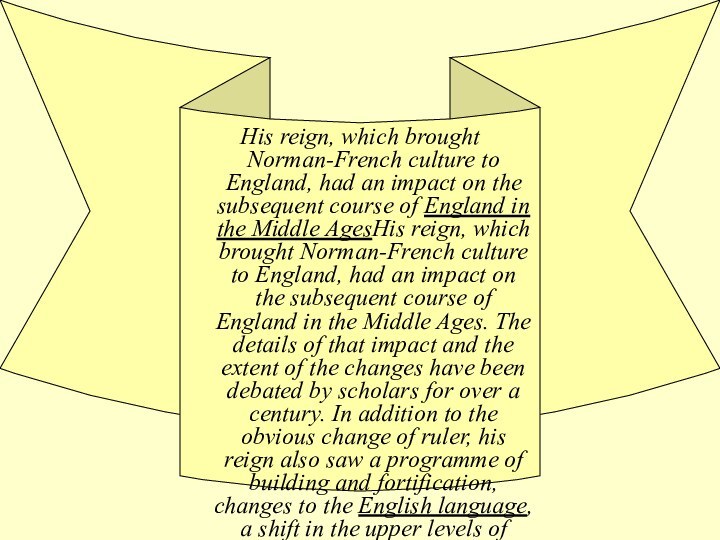
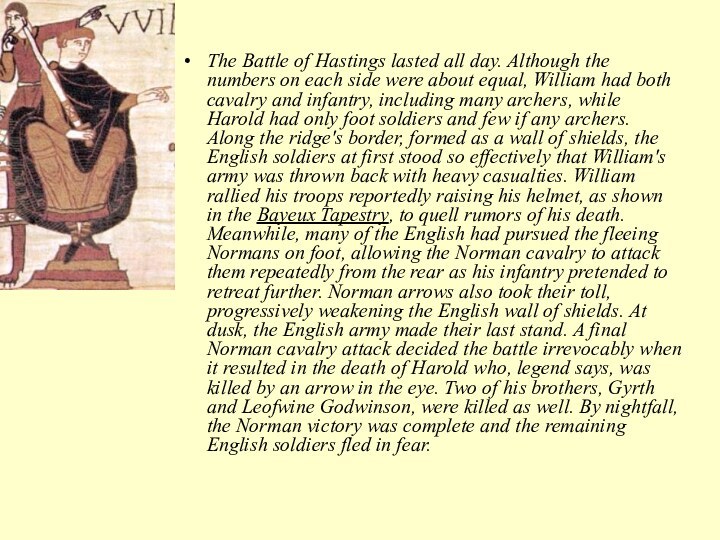
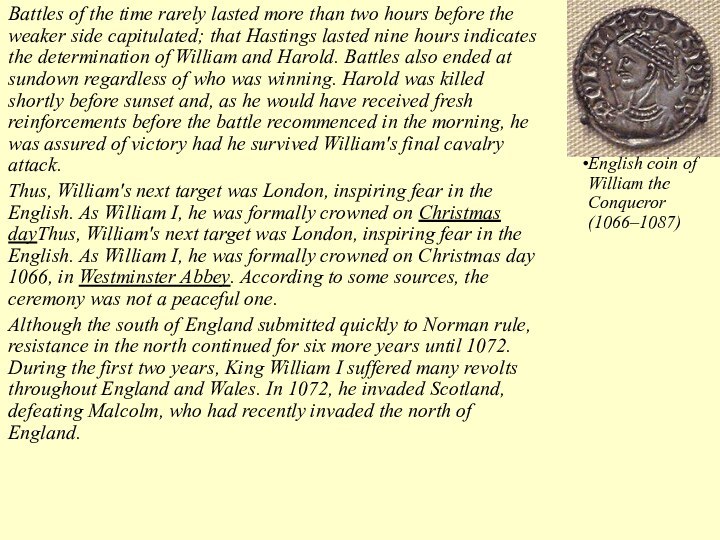
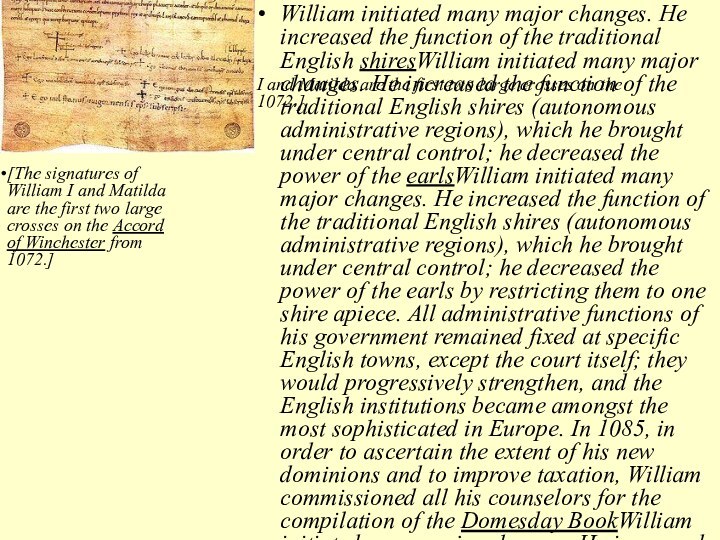
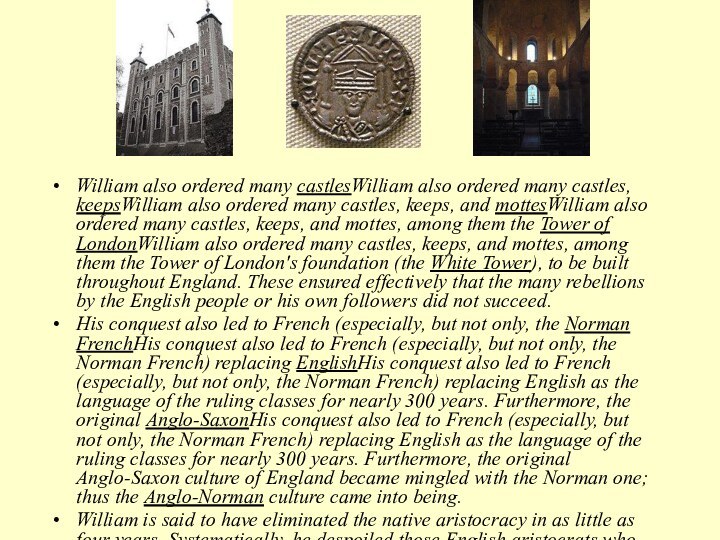
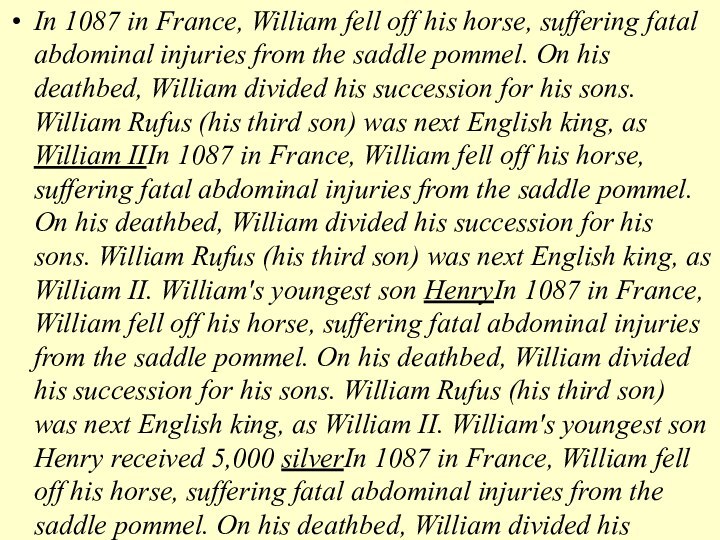
Слайд 3
The Battle of Hastings lasted all day. Although
the numbers on each side were about equal, William
had both cavalry and infantry, including many archers, while Harold had only foot soldiers and few if any archers. Along the ridge's border, formed as a wall of shields, the English soldiers at first stood so effectively that William's army was thrown back with heavy casualties. William rallied his troops reportedly raising his helmet, as shown in the Bayeux Tapestry, to quell rumors of his death. Meanwhile, many of the English had pursued the fleeing Normans on foot, allowing the Norman cavalry to attack them repeatedly from the rear as his infantry pretended to retreat further. Norman arrows also took their toll, progressively weakening the English wall of shields. At dusk, the English army made their last stand. A final Norman cavalry attack decided the battle irrevocably when it resulted in the death of Harold who, legend says, was killed by an arrow in the eye. Two of his brothers, Gyrth and Leofwine Godwinson, were killed as well. By nightfall, the Norman victory was complete and the remaining English soldiers fled in fear.
Слайд 4
English coin of William the Conqueror (1066–1087)
Battles of
the time rarely lasted more than two hours before
the weaker side capitulated; that Hastings lasted nine hours indicates the determination of William and Harold. Battles also ended at sundown regardless of who was winning. Harold was killed shortly before sunset and, as he would have received fresh reinforcements before the battle recommenced in the morning, he was assured of victory had he survived William's final cavalry attack.Thus, William's next target was London, inspiring fear in the English. As William I, he was formally crowned on Christmas dayThus, William's next target was London, inspiring fear in the English. As William I, he was formally crowned on Christmas day 1066, in Westminster Abbey. According to some sources, the ceremony was not a peaceful one.
Although the south of England submitted quickly to Norman rule, resistance in the north continued for six more years until 1072. During the first two years, King William I suffered many revolts throughout England and Wales. In 1072, he invaded Scotland, defeating Malcolm, who had recently invaded the north of England.
English coin of William the Conqueror (1066–1087)
Слайд 5 [The signatures of William I and Matilda are
the first two large crosses on the Accord of
Winchester from 1072.]William initiated many major changes. He increased the function of the traditional English shiresWilliam initiated many major changes. He increased the function of the traditional English shires (autonomous administrative regions), which he brought under central control; he decreased the power of the earlsWilliam initiated many major changes. He increased the function of the traditional English shires (autonomous administrative regions), which he brought under central control; he decreased the power of the earls by restricting them to one shire apiece. All administrative functions of his government remained fixed at specific English towns, except the court itself; they would progressively strengthen, and the English institutions became amongst the most sophisticated in Europe. In 1085, in order to ascertain the extent of his new dominions and to improve taxation, William commissioned all his counselors for the compilation of the Domesday BookWilliam initiated many major changes. He increased the function of the traditional English shires (autonomous administrative regions), which he brought under central control; he decreased the power of the earls by restricting them to one shire apiece. All administrative functions of his government remained fixed at specific English towns, except the court itself; they would progressively strengthen, and the English institutions became amongst the most sophisticated in Europe. In 1085, in order to ascertain the extent of his new dominions and to improve taxation, William commissioned all his counselors for the compilation of the Domesday Book, which was published in 1086. The book was a survey of England's productive capacity similar to a modern census.
[The signatures of William I and Matilda are the first two large crosses on the Accord of Winchester from 1072.]
Слайд 6
William also ordered many castlesWilliam also ordered many
castles, keepsWilliam also ordered many castles, keeps, and mottesWilliam
also ordered many castles, keeps, and mottes, among them the Tower of LondonWilliam also ordered many castles, keeps, and mottes, among them the Tower of London's foundation (the White Tower), to be built throughout England. These ensured effectively that the many rebellions by the English people or his own followers did not succeed.His conquest also led to French (especially, but not only, the Norman FrenchHis conquest also led to French (especially, but not only, the Norman French) replacing EnglishHis conquest also led to French (especially, but not only, the Norman French) replacing English as the language of the ruling classes for nearly 300 years. Furthermore, the original Anglo-SaxonHis conquest also led to French (especially, but not only, the Norman French) replacing English as the language of the ruling classes for nearly 300 years. Furthermore, the original Anglo-Saxon culture of England became mingled with the Norman one; thus the Anglo-Norman culture came into being.
William is said to have eliminated the native aristocracy in as little as four years. Systematically, he despoiled those English aristocrats who opposed the Normans. Many English aristocrats fled to FlandersWilliam is said to have eliminated the native aristocracy in as little as four years. Systematically, he despoiled those English aristocrats who opposed the Normans. Many English aristocrats fled to Flanders and Scotland; others may have been sold into slavery overseas. However, to the new Norman noblemen, William handed the English land widely. Effectively, this strengthened William's political stand as a monarch.





















![Звуки [д], [д\], позначення їх буквою Д д](/img/tmb/13/1284528/97a9dddc35723615544475bacd0f6106-210x.jpg)





